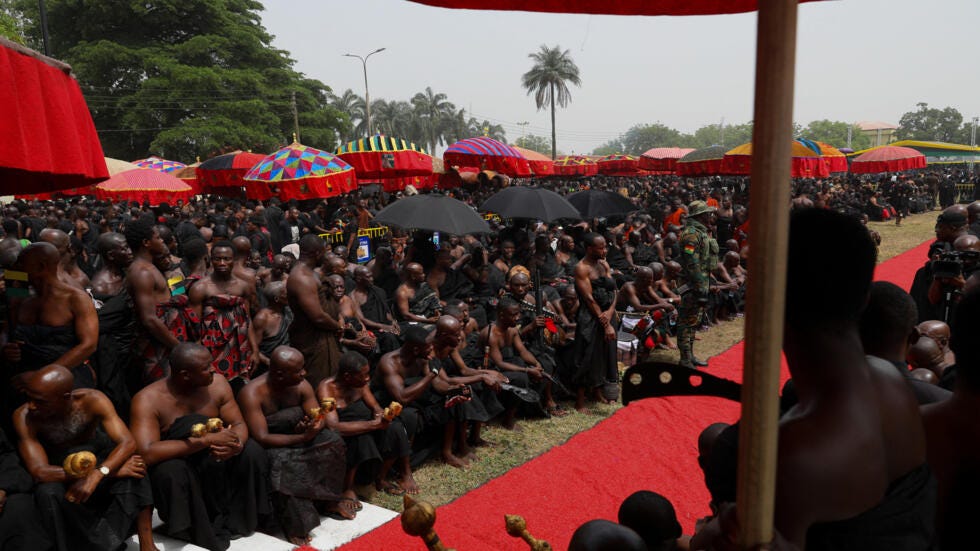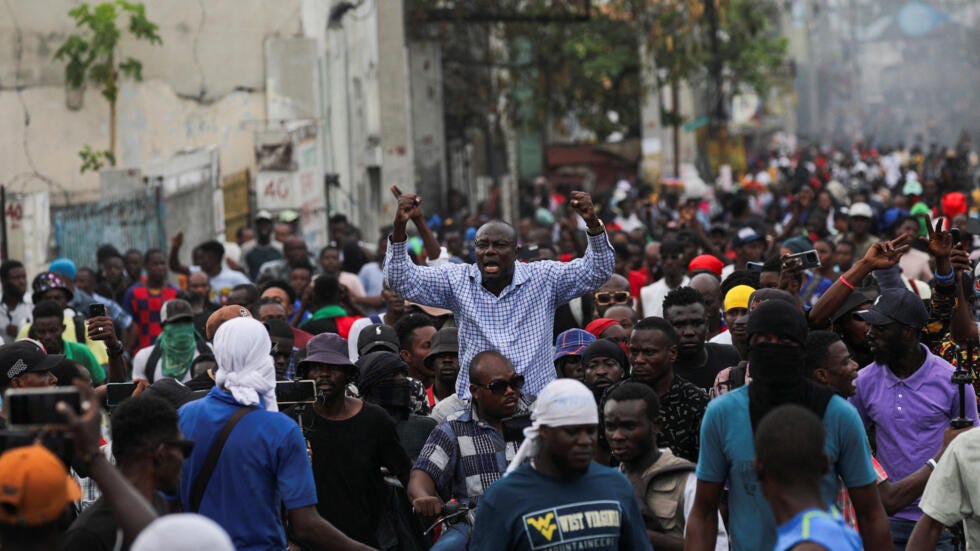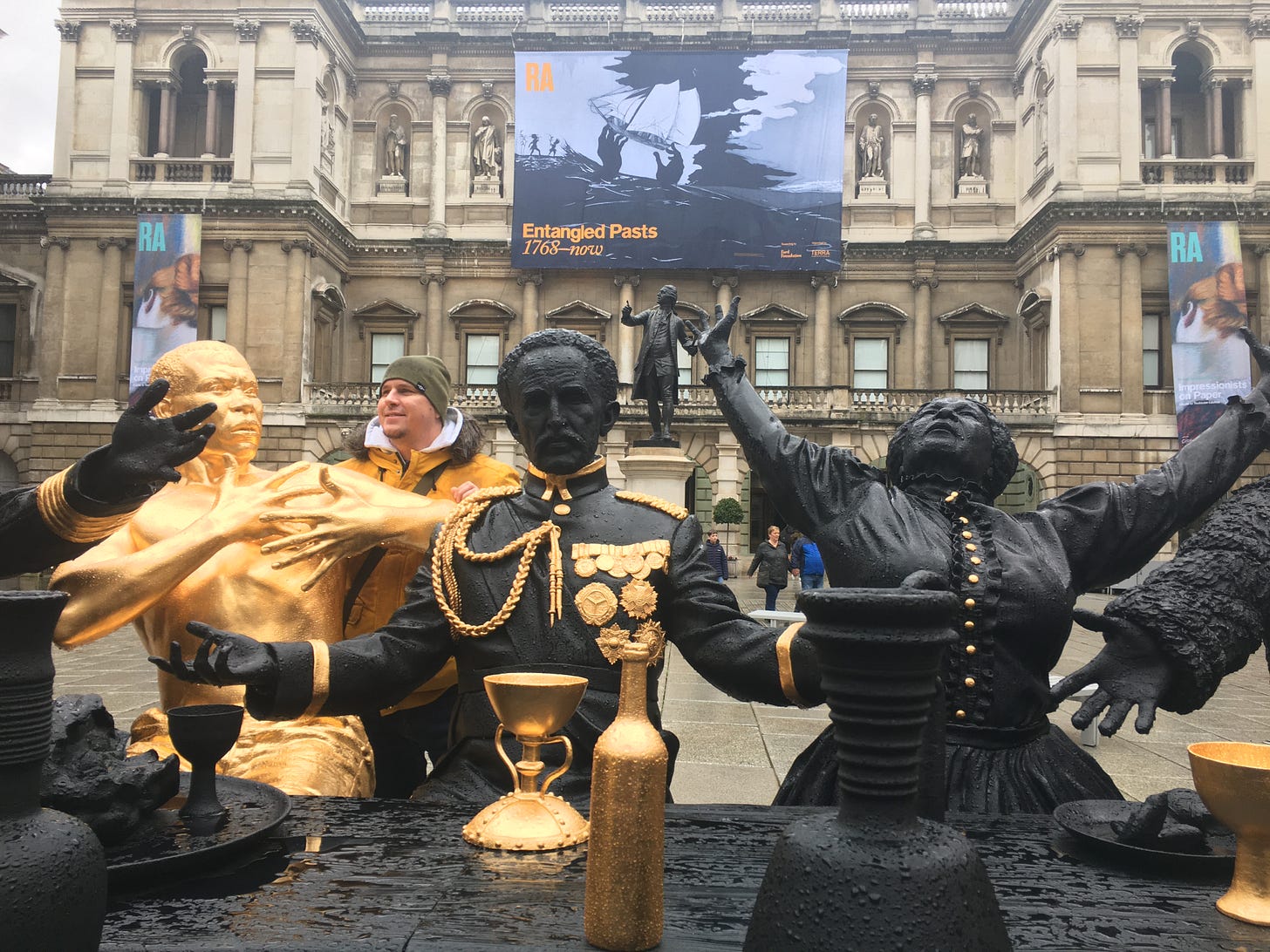'Talking about revolutions'... and colonialism
A few reflections on recent art exhibitions tackling protests, post-colonial battles, and social change
18 February 2024
Dear readers,
I hope this new post finds you well.
It comes a bit later than usual in recent months, as I was awfully busy.
Some highlights: I went to London to take part in one of the events related to the groundbreaking exhibition ‘Entangled Pasts’, which opened at the Royal Academy earlier in February.
Here is The Observer’s review:
Entangled Pasts: Art, Colonialism and Change review – the most radical show in the RA’s history
*
And while in London, I had the chance to see three other exhibitions dealing with the same themes, i.e. the relations between the arts and change, revolts, revolutionary impulse…
These discussed both women’s rights and indigenous people’s rights, how to get rid of colonial violence / domination, and how to gain agency after the change.
The story of my life, as a politically active citizen and as a journalist.
In the meantime, in my ‘day job’, I covered many protests, especially in Senegal, from Senegalese abroad, and for Palestinians.
Here are a few reflections on key themes that have been in my writing for almost 20 years…
Royal Academy: From old empires to rumbling revolutions?
When I was asked to give a talk at the Royal Academy on ‘Art & Revolution’, I imagined that most people coming would already have in mind the famous French and American revolutions. Yet, so many other revolutions took place and shook the modern world, built the world as we know it today: in Russia, in Cuba, in the Caribbean and in Africa.
I chose to highlight the latest, and especially the Haitian Revolution, a part of American history which gives an immense perspective on the evolution of the Western world, to this day.
I mentioned the art of Eugène Delacroix, painter of the Second French Revolution of 1830, and the recent work of the young French painter Raphael Barontini, who recently stormed the very ceremonial Panthéon with his exhibition ‘We Could Be Heroes.’
I could talk for hours about his art, which I discovered a few years ago at the Mariane Ibrahim gallery, thanks to my friend working in the contemporary art world in Paris.
I also met with Raphael in December in his studio in Saint-Denis, north of Paris, to discuss more of his motivation, artistic process and experiences.
Raphael was offered a “carte blanche” at Le Panthéon and immediately decided to evoke the history and memory of forgotten heroes, the ones involved in the fights against slavery notably.
Trained at the Famous Paris’ Ecole des Beaux-Arts, Raphael also grew up in Seine-Saint-Denis, in a family mixing children of Italian communists and “resistants” on his father’s side, and Caribbean roots on his mother’s side, from both French Guyana and Guadeloupe. Saint-Denis is also a decade-long socialist then communist city at the heart of a working-class suburb of the capital. It has a long tradition of resistance…
The Pantheon is a place of “republican memory”, which honours “several personalities who worked for the abolition of slavery, such as Condorcet, Abbé Grégoire, Toussaint Louverture, Louis Delgrès or Victor Schœlcher”, but none of them Black people.
Raphaël Barontini has now corrected that fact in a way.
His figures, painted on banners and flags, depict heroic protesters and activists involved in the fight against slavery and for citizens’ rights, known or very much less known, who have contributed to playing a significant role in its abolition.
They form his “imaginary pantheon”.
More than half of them are women, and many have been revered names among African diaspora, like the Haitian Toussaint Louverture, Henri Christophe and Jean-Jacques Dessalines.
I was very inspired by my conversation with the artist, and very moved by the performances he organised for the show, storming the Pantheon with dancers from a ‘mas’, a group illuminating a celebratory Caribbean carnival.
Raphael’s next exhibition will be at Currier Museum (in Manchester, New Hampshire, USA) - in March-June 2024.
He will also be the artist in residence in New Orleans with Villa Albertini through the spring.
I also mentioned the art celebrating the Algerian revolution and the independence of Burkina Faso during my presentation, as much as the representation of the Gazan struggle in Banksy’s public art.
Then coincidentally, I was invited invited the very next day to the opening of the UK debut of French Algerian artist Zineb Sedira’s critically acclaimed exhibition ‘Dreams Have No Titles’ at Whitechapel Gallery in London, inspired by her parent’s youth in post-colonial Algeria.
Presentation:
Originally conceived for the French Pavilion at the 59th Venice Biennale in 2022, ‘Dreams Have No Titles’ is an immersive installation comprising film, sculpture, photography and performance. The show interweaves the artist’s biography with activist films produced across France, Algeria and Italy in the 1960s and 1970s, a pivotal moment in the history of avant-garde film production.
Sedira transforms Whitechapel’s exhibition spaces into a series of film sets. In one gallery you discover a ballroom (complete with live performances), in another, a recreation of the artist’s Brixton living room, while upstairs sees a full-scale cinema to screen Sedira’s film of the same name, ‘Dreams Have No Titles’.
On view until 12 May
I had met Zineb in December 2021, in her studio in Brixton, London, and we discussed her plans for this exhibition.
I wrote about it a few months later.
> My story from 2022:
Zineb Sedira Triumphs for France/Algeria at 59th Venice Biennale
2 May 2022 • Melissa Chemam
Video artist Zineb Sedira is not the kind of woman who will back down when faced with a direct challenge, so when a pro-Israel group attempted to have her dismissed as France’s representative at an upcoming Venice Biennale, because of past expressions of support for the Palestinian people, she held fast to her convictions. Even though she has previously described herself as a “political” artist with a small “p” only, Sedira refused to resign even as the pressure mounted.
At the end of the day, the artist — born in Paris to Algerian parents — proudly represented the country of her birth at the 2022 Venice Biennale, which had been postponed for a year due to Covid. She was the first artist of Algerian origin ever selected to represent France, and only the fourth woman since 1912. Then Sedira’s French pavilion in the 59th Biennale received the Special Mention of the Jury.
Her cinematographic installation, “Dreams Have No Titles” (Les Rêves n’ont pas de titre), focused on Algerian cinema of the 1960s and ‘70s. Coming at nearly the 60th anniversary of Algeria’s independence from France, the pavilion could not have been more timely, even if celebrating Algerian independence for some French might have felt like a sharp stick in the eye.
“I spent a lot of time at the Cinémathèque d’Alger for this installation, especially with the new director, Salim Agar,” Zineb Sedira confided to me in an interview in her Brixton studio, where she has worked for the last two decades. “I became interested in film co-productions between Algeria, France and Italy, starting with The Battle of Algiers.”
Link to read the whole story: https://themarkaz.org/zineb-sedira-triumphs-for-france-algeria-at-59th-venice-biennale/
The enduring impact of colonialism
What my work on art reflecting our past and my work as a journalist in our days have in common is this repetitive need to fight for our rights. Even for battles that seemed already won.
Most of us, who don’t belong to the elite or the protected, privileged middle classes of the west, have had to fight to defend their rights to be treated equally, at some point or another.
And recent events in the world are strikingly reflecting these efforts, whether in Russia, in Africa or in Europe.
Recently, debates for recognition of past wounds born out of colonialism have also come back to haunt the present.
Here are two recent examples, with articles I wrote for Rfi English…
…In Algeria:
France and Algeria revisit painful past in battle to mend colonial wounds
A commission of French and Algerian historians created to reconcile colonial difficulties has agreed proposals for the exchange of archives, remains and artefacts. It is hoped the 10-member body – set up in August 2022 by presidents Emmanuel Macron and Abdelmadjid Tebboune – will help the countries turn the page on a shared and painful past.
… and in Ghana:
After Britain, the US sends looted royal artefacts to Ghana’s Ashanti King
A California museum returned seven royal artefacts to Ghana’s traditional Ashanti king to commemorate his silver jubilee in the first planned handovers of Ashanti treasures looted during colonial times.
Issued on: 12/02/2024

Ghana's royal treasures from the Fowler Museum include a gold necklace, an ornamental chair and an elephant tail whisk.
They were presented during a ceremony of chiefs at the Manhyia Palace in the city of Kumasi in the Ashanti region.
Royal Ashanti gold objects are believed to be invested with the spirits of former rulers.
-
Professor of Contemporary Archaeology at University of Oxford Dan Hicks wrote the return to Ghana was "long overdue".
Neighbouring Nigeria is also negotiating the return of thousands of 16th to 18th century metal objects looted from the ancient kingdom of Benin and currently held by museums and art collectors across the United States and Europe.
Two years ago, Benin received two dozen treasures and artworks stolen in 1892 by French colonial forces.
Egypt and Ethiopia also want the British Museum to return a number of items taken during colonial conquests, while Algeria expects artefacts and even human remains to be returned from France.
This problem made headline elsewhere too, see in The Guardian, a piece published this very Sunday, while I was drafting this post:
France should return much more looted African art, film-maker says
Mati Diop, the director of Dahomey, which charts the restitution of 26 objects to Benin, says the tiny number involved is ‘humiliating’
This energy is also taking over other parts of the world, sometimes with less positive outcome.
Such as Haiti, that I mentioned earlier. For other complexe reasons I don’t have time to develop here (though I wish I could!).
But here is an article on the latest:
Hundreds protest government in Haiti despite police tear gas, demand PM resignation
A former rebel leader arrived in Haiti’s capital on Tuesday amid large protests across the country for the second consecutive day, demanding the ouster of Prime Minister Ariel Henry.

Haitian national police used tear gas to disperse protesters, who set fire to car tires, filling streets with clouds of grey smoke.
Henry assumed power shortly after the assassination of the country's last president, Jovenel Moise, in 2021. Since then a power vacuum has allowed the rise of powerful gangs who have largely gathered around two main alliances, G9 and G-Pep.
The protests shut down major cities in Haiti on Monday, as demonstrators clashed with police and demanded the resignation of the Prime Minister.
Banks, schools and government agencies closed in Haiti’s northern and southern regions while protesters blocked main routes with blazing tires and paralyzed public transportation, according to local media reports.
In Hinche, a city in Haiti’s central region, protesters celebrated the arrival of heavily armed state environmental agents and their commander, Joseph Jean Baptiste, who demanded that Henry resign.
*
And then of course, in Gaza.
As the horrible and violent war led by the Israeli army moves south around Rafah, millions are displaced, facing starvation, despair and death.
Sadly, the media coverage in Europe and in America only makes things worse.
"The problems of international news coverage will not be resolved by simple appeals to journalistic codes without addressing deeper systemic issues," recently wrote Patrick Gathara in The New Humanitarian, stating that “Biased Gaza coverage is the tip of a much larger media iceberg”.
As many Palestinians and defenders of human rights carry on protesting, artists are also trying to gain more visibility.
I was lucky to be able to see a small exhibition in London, at P21.
GO if you can:
From Palestine with Art
Curated by Faisal Saleh, Founder & Executive Director, Palestine Museum US, 1764 Litchfield Turnpike, Woodbridge, Connecticut 06525, USA
Participating Artists: Karim Abu Shakra, Salman Abu Sitta, Ghassan Abu Laban, Ibrahim Alazza, Mohammed Alhaj, Nabil Anani, Hanan Awad, Samira Badran, Jacqueline Bejani, Sana Farah Bishara, Susan Bushnaq, Lux Eterna, Nadia Irshaid Gilbert, Samia Halaby, Rula Halawani, Samar Hussaini, Mohamed Khalil, Rania Matar, Sobhiya Hasan Qais, Nameer Qassim, and Taqi Sabateen.
I could carry on with other exhibitions for pages, but words here are limited. Maybe in the next posts.
Thanks for reading as usual.
Feedback and comments are always welcome too.
Wishing you all the best, and keep on fighting,
melissa
-
Melissa Chemam
Journalist @ RFI English
Music/Art Writer @ New Arab, ART UK...
Site: https://sites.google.com/view/melissachemam
Newsletter:
-





